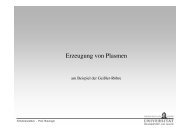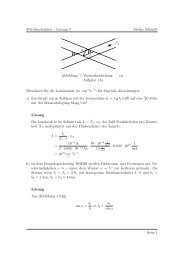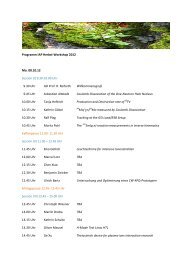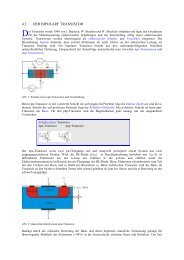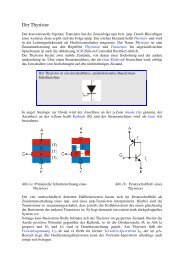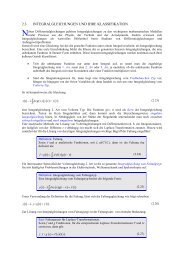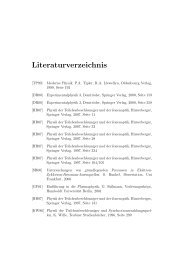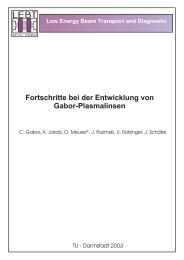Non-neutral and partially neutralized plasma studies in the CNT ...
Non-neutral and partially neutralized plasma studies in the CNT ...
Non-neutral and partially neutralized plasma studies in the CNT ...
You also want an ePaper? Increase the reach of your titles
YUMPU automatically turns print PDFs into web optimized ePapers that Google loves.
<strong>Non</strong>-<strong>neutral</strong> <strong>and</strong> <strong>partially</strong> <strong>neutral</strong>ized<br />
<strong>plasma</strong> <strong>studies</strong> <strong>in</strong> <strong>the</strong> <strong>CNT</strong> stellarator<br />
Columbia University<br />
In <strong>the</strong> City of New York<br />
Thomas Sunn Pedersen<br />
<strong>CNT</strong> group, Columbia University, New York, USA<br />
IPP-Greifswald, Germany<br />
<strong>CNT</strong>
Overview<br />
• Introduction to <strong>the</strong> basic physics of non-<strong>neutral</strong> <strong>plasma</strong>s<br />
• Physics of pure electron <strong>plasma</strong>s <strong>in</strong> stellarators<br />
– Motivation <strong>and</strong> history<br />
– Experimental <strong>in</strong>vestigation of conf<strong>in</strong>ement <strong>in</strong> <strong>CNT</strong><br />
– Orbit simulations for <strong>CNT</strong><br />
– Conf<strong>in</strong>ement improvement<br />
– Operation <strong>and</strong> diagnosis of <strong>plasma</strong>s without <strong>in</strong>ternal objects<br />
• Physics of <strong>partially</strong> <strong>neutral</strong>ized <strong>plasma</strong>s<br />
– More or less unexplored territory – will show <strong>in</strong>itial “map”<br />
• Plans for electron-positron <strong>plasma</strong>s<br />
• Summary
€<br />
Some basic characteristics of non-<strong>neutral</strong> <strong>plasma</strong>s<br />
• <strong>Non</strong>-<strong>neutral</strong> <strong>plasma</strong>s are def<strong>in</strong>ed similarly to quasi<strong>neutral</strong> <strong>plasma</strong>s <strong>and</strong><br />
<strong>the</strong>refore display collective behavior:<br />
λ D >1<br />
ε 0∇ 2 ϕ = en e ⇔ε 0 ϕ /a 2 ≈ en e ⇔ ϕ ≈ en ea 2 /ε 0<br />
⇔ eϕ<br />
T ≈ e2 n e<br />
ε 0T e<br />
v E×B<br />
v ∇B<br />
• For a quasi<strong>neutral</strong> <strong>plasma</strong>,<br />
€<br />
= ∇ϕ /B<br />
a 2 = a2<br />
2<br />
λD eϕ<br />
≈ 2<br />
T ∇B /eB T >>1<br />
€<br />
eϕ<br />
T<br />
>>1⇔ eϕ<br />
T >>1<br />
~ 1
Why study non-<strong>neutral</strong> <strong>plasma</strong>s?<br />
• Small scale experiments with <strong>in</strong>terest<strong>in</strong>g <strong>and</strong> unique physics -<br />
excellent for University research<br />
• Global <strong>the</strong>rmal equilibrium can be obta<strong>in</strong>ed (<strong>in</strong> some traps)<br />
• Plasmas are highly reproducible, low noise (<strong>in</strong> some traps)<br />
• Long time conf<strong>in</strong>ement of antimatter can lead to <strong>in</strong>terest<strong>in</strong>g physics:<br />
– Antihydrogen<br />
• Long time conf<strong>in</strong>ement <strong>and</strong> cool<strong>in</strong>g of just a few particles<br />
– (Precision spectroscopy, solid state physics, crystal formation)<br />
• Can study phenomena of broad <strong>in</strong>terest<br />
– Example 1: Neoclassical conf<strong>in</strong>ement <strong>in</strong> stellarators <strong>in</strong> <strong>the</strong> “ion root” regime<br />
– Example 2: Electron-positron <strong>plasma</strong>s<br />
– Example 3: High <strong>in</strong>tensity beams
Penn<strong>in</strong>g Trap: Why it conf<strong>in</strong>es s<strong>in</strong>gle<br />
component <strong>plasma</strong>s so well<br />
Cyl<strong>in</strong>drical symmetry, s<strong>in</strong>gle species => long conf<strong>in</strong>ement time<br />
Pθ = [m vθ iri + eB<br />
N<br />
∑ i<br />
2c<br />
2<br />
N eB<br />
Pθ = ∑ i r ] = const.<br />
2c<br />
2 Pθ = [m vr θ ir= i + const.<br />
eB<br />
N<br />
∑ i<br />
2c<br />
2 r ] = const.<br />
i=1<br />
Note: For a <strong>neutral</strong> <strong>plasma</strong>, this conservation does not restrict <strong>the</strong> radial transport!<br />
Conf<strong>in</strong>ed <strong>the</strong>rmal equilibrium: T uniform, ω uniform (rigid rotor)<br />
Davidson <strong>and</strong> Krall, Phys. Fluids 1970<br />
Dub<strong>in</strong> <strong>and</strong> O’Neil, R.M.P. 1999
Pure electron <strong>plasma</strong>s <strong>in</strong> a pure toroidal magnetic field:<br />
Lawrence <strong>Non</strong>-<strong>neutral</strong> Torus II<br />
• Experiment led by Matt Stonek<strong>in</strong>g, Lawrence University, Wiscons<strong>in</strong><br />
• Pure toroidal field<br />
• Predicted excellent particle conf<strong>in</strong>ement because <strong>the</strong> ExB drift provides<br />
an effective rotational transform (poloidal motion), <strong>and</strong><br />
• Results presented here are from a partial torus (“a bent Penn<strong>in</strong>g trap”)<br />
• Conf<strong>in</strong>ement is worse for a full torus by <strong>the</strong> way!<br />
• Plasma major radius: 17.4 cm<br />
• Plasma m<strong>in</strong>or radius: ~1.3 cm<br />
• Length: 82 cm (270 degrees)<br />
109 cm (360 degrees)<br />
€<br />
v ExB >> v ∇B
Observation of m=1 Diocotron Mode (ExB<br />
rotation of <strong>the</strong> entire <strong>plasma</strong>)<br />
Signal (mV)<br />
0 50 100 150<br />
Time (ms)<br />
Marler <strong>and</strong> Stonek<strong>in</strong>g, PRL 100, 155001 (2008)<br />
<strong>in</strong>side<br />
top<br />
outside<br />
bottom
• Frequency decays on ~3 s<br />
timescale charge<br />
conf<strong>in</strong>ement time.<br />
• ~100X improvement over<br />
previous non-<strong>neutral</strong> pure<br />
toroidal field experiments.<br />
• Approaches <strong>the</strong>oretical<br />
predictions (<strong>in</strong>f<strong>in</strong>ite<br />
conf<strong>in</strong>ement is not expected<br />
here)<br />
Conf<strong>in</strong>ement Time
<strong>Non</strong>-<strong>neutral</strong> <strong>plasma</strong>s <strong>in</strong> a stellarator<br />
• The stellarator concept was developed for fusion 60 years ago<br />
• Stellarators have some advantages over Penn<strong>in</strong>g <strong>and</strong> pure<br />
toroidal traps, <strong>and</strong> some disadvantages:<br />
– Fully toroidal – no end effects<br />
– Can conf<strong>in</strong>e <strong>plasma</strong> well even <strong>in</strong> <strong>the</strong> absence of significant space charge:<br />
• Not true for pure toroidal trap<br />
– Can conf<strong>in</strong>e both signs of charge simultaneously<br />
• Not true for Penn<strong>in</strong>g trap<br />
• Allows <strong>studies</strong> of partly <strong>neutral</strong>ized <strong>plasma</strong>s, <strong>and</strong> arbitrarily low density<br />
non-<strong>neutral</strong> <strong>plasma</strong>s<br />
• Can conf<strong>in</strong>e electron-positron <strong>plasma</strong>s<br />
– Because of <strong>the</strong> lack of symmetry, conf<strong>in</strong>ement may be bad<br />
• Should be ra<strong>the</strong>r good by stellarator st<strong>and</strong>ards
<strong>Non</strong>-<strong>neutral</strong> <strong>plasma</strong>s <strong>in</strong> a stellarator<br />
• A stellarator is a magnetic surface configuration: Each<br />
magnetic field l<strong>in</strong>e wraps around a toroidal surface, never<br />
leav<strong>in</strong>g <strong>the</strong> surface.
<strong>Non</strong>-<strong>neutral</strong> <strong>plasma</strong>s <strong>in</strong> a stellarator<br />
• The non-<strong>neutral</strong> stellarator idea is about 10 years old<br />
– (Sunn Pedersen <strong>and</strong> Boozer, PRL 88, 2002)<br />
– Equilibrium equation derived<br />
– Unique capabilities recognized<br />
• BUT! very similar experiments were actually performed >20<br />
years ago!<br />
– Auburn torsatron (USA, 1987), <strong>and</strong> Uragan-2, Uragan-3 (USSR, 1988)<br />
“Stellarator diode” – a field l<strong>in</strong>e mapp<strong>in</strong>g technique<br />
– Drawbacks of this field l<strong>in</strong>e mapp<strong>in</strong>g technique <strong>and</strong> were likely caused by<br />
<strong>the</strong> creation of pure electron <strong>plasma</strong>s <strong>and</strong> <strong>the</strong> associated collective effects<br />
made <strong>the</strong> situation complicated!<br />
• Now, several stellarators do non-<strong>neutral</strong> physics<br />
– <strong>CNT</strong> (this talk)<br />
– CHS, Japan (until recently)<br />
• There are also NNP <strong>studies</strong> <strong>in</strong> dipoles now (RT-1, Saitoh et al.<br />
Japan)
<strong>CNT</strong>: A stellarator dedicated to NNP physics s<strong>in</strong>ce 2004
<strong>CNT</strong> is a simple <strong>and</strong> compact stellarator<br />
1 Gourdon et al., Plas. Phys. Contrl. Nucl. Fus. Research p. 849 (1969)<br />
2 Pedersen et al., Fusion Sci. Tech. 46 p 200 (2004)
Neoclassical transport<br />
• A charged particle performs a screw-like path if it is conf<strong>in</strong>ed by a<br />
straight uniform magnetic field <strong>and</strong> it feels no o<strong>the</strong>r forces<br />
• However, if <strong>the</strong> field is not that simple, or if electric fields are<br />
present, <strong>the</strong> particle drifts <strong>in</strong> addition – usually slowly compared to<br />
<strong>the</strong> parallel motion.<br />
• Example:<br />
€<br />
∇B
Neoclassical transport <strong>and</strong> ExB drift<br />
• S<strong>in</strong>ce <strong>the</strong> parallel free stream<strong>in</strong>g leads to no transport from surface<br />
to surface, transport rates are usually determ<strong>in</strong>ed by <strong>the</strong>se drifts<br />
• Example: E
First expectation of neoclassical conf<strong>in</strong>ement <strong>in</strong> <strong>CNT</strong><br />
• <strong>CNT</strong>’s pure electron <strong>plasma</strong>s are (paradoxically) <strong>in</strong> <strong>the</strong> extreme<br />
“ion root” of stellarator neoclassical transport<br />
• <strong>CNT</strong>: Δϕ~200 V, T e ~4 eV<br />
v ExB<br />
v ∇B<br />
≈ eφ<br />
T e<br />
≈ 50<br />
• S<strong>in</strong>ce ExB drift dom<strong>in</strong>ates over grad B <strong>and</strong> curvature drifts it should<br />
close o<strong>the</strong>rwise bad orbits € (just as it does <strong>in</strong> <strong>the</strong> pure toroidal field<br />
trap – LNT II)<br />
• Much reduced neoclassical transport (squeez<strong>in</strong>g of drift orbits <strong>and</strong><br />
absence of bad orbits)
Experimental f<strong>in</strong>d<strong>in</strong>g 1: Internal rods drive transport<br />
Insulated rods charge up negative relative to <strong>plasma</strong> to self-shield<br />
Result<strong>in</strong>g ExB drift pattern convects particles along <strong>the</strong> rod all <strong>the</strong> way to<br />
<strong>the</strong> open field l<strong>in</strong>es.<br />
J. P. Kremer et al., PRL 97 (2006)<br />
J. W. Berkery et al., Phys. Plasmas 14 062503 (2007)
Exp. F<strong>in</strong>d<strong>in</strong>g 2: Neutrals also degrade conf<strong>in</strong>ement
Exp. F<strong>in</strong>d<strong>in</strong>g 2.1: Neutrals degrade conf<strong>in</strong>ement a lot<br />
The loss rate due to <strong>neutral</strong> collisions is much larger than expected:<br />
We would lose an electron after order unity electron-<strong>neutral</strong> collisions!<br />
This is suggestive of poor particle orbit quality despite <strong>the</strong> large ExB<br />
drift<br />
More detailed underst<strong>and</strong><strong>in</strong>g of orbits <strong>in</strong> <strong>CNT</strong> needed:<br />
Numerical study:<br />
Confirmed good orbits when <strong>the</strong> electric potential does not vary on a<br />
magnetic surface<br />
But when we use a realistic electrostatic potential (one that varies on<br />
magnetic surfaces as a result of <strong>the</strong> electrostatic boundary condition <strong>in</strong><br />
<strong>CNT</strong>), we see poor orbits (next few slides)<br />
Details published <strong>in</strong>: “Numerical <strong>in</strong>vestigation of electron trajectories <strong>in</strong> <strong>the</strong> Columbia <strong>Non</strong><strong>neutral</strong><br />
Torus”, B. Dur<strong>and</strong> de Gevigney et al, Physics of Plasmas 16, article 122502 (2009)
Simulation 1: No electric field<br />
If <strong>the</strong> electric field is weak, <strong>the</strong> ExB drift is small, magnetic drifts<br />
important<br />
<strong>CNT</strong> is a “classical stellarator” – will not work well for fusion:<br />
About 50% of particles are magnetically trapped <strong>and</strong> drift out of <strong>CNT</strong>.<br />
Example here at zero E-field:
Simulation 2: Idealized electric field<br />
A strong space charge electric field – constant on a magnetic surface –<br />
is added to <strong>the</strong> simulation of <strong>the</strong> trapped particle<br />
Now it is conf<strong>in</strong>ed!
Simulation 3: <strong>Non</strong>-conform<strong>in</strong>g boundary condition<br />
Until 2008, <strong>the</strong> <strong>in</strong>ternal coils <strong>and</strong> vacuum chamber set <strong>the</strong> electrostatic<br />
boundary condition caus<strong>in</strong>g large electrostatic potential<br />
perturbations, especially <strong>in</strong> <strong>the</strong> edge region
Simulation 4: Idealized electric field with resonance orbit<br />
Orbits can make large excursions even with <strong>the</strong> idealized electric field<br />
This is a resonance phenomenon – only a small fraction of particle orbits are<br />
affected: ExB cancels poloidal part of parallel motion for pass<strong>in</strong>g particles<br />
Similar apperance to tokamak “banana” orbits – but for pass<strong>in</strong>g particles<br />
(banana orbits <strong>in</strong> tokamaks are magnetically trapped)
Intuitive picture of collisionless loss orbits with E<br />
• ExB (perpendicular motion) takes electron along electrostatic<br />
potential contour<br />
• Parallel motion of pass<strong>in</strong>g electrons (comb<strong>in</strong>ed with rotational<br />
transform) takes electrons along <strong>the</strong> magnetic surface, mov<strong>in</strong>g<br />
<strong>the</strong>m poloidally<br />
• By switch<strong>in</strong>g between potential contours <strong>and</strong> magnetic surfaces,<br />
particles can make enormous radial excursions
Flux surface conform<strong>in</strong>g electrostatic boundary<br />
• “Faraday cage” should br<strong>in</strong>g us<br />
close to <strong>the</strong> ideal electric field<br />
(case 2)<br />
• Was <strong>in</strong>stalled 2007-2010<br />
• Was never perfectly aligned to<br />
<strong>the</strong> magnetic surfaces<br />
• The mesh improved<br />
conf<strong>in</strong>ement significantly<br />
despite its flaws – but<br />
conf<strong>in</strong>ement improvements<br />
were not exactly as expected<br />
P. W. Brenner et al., accepted <strong>in</strong> Contributions to Plasma Physics
Record conf<strong>in</strong>ement (for a stellarator): 0.32 seconds<br />
Conf<strong>in</strong>ement time <strong>in</strong>crease is due ma<strong>in</strong>ly to better vacuum <strong>and</strong> a higher Bfield<br />
but also due to smaller Debye length <strong>and</strong> improved orbit quality<br />
Next step: Elim<strong>in</strong>ate rods<br />
1 P. W. Brenner et al., Contributions to Plasma Physics (2010)
Emitter capable of retraction <strong>in</strong> 20 msec <strong>in</strong>stalled: There should be <strong>plasma</strong> left<br />
Design: Berkery et al. RSI (78) 2007<br />
In Surfaces<br />
Retracted
First results from retraction experiments were disappo<strong>in</strong>t<strong>in</strong>g<br />
Even though retraction <strong>in</strong> 20 msec was achieved, <strong>the</strong>re appeared to be no<br />
<strong>plasma</strong> left after retraction<br />
True even for conditions that should result <strong>in</strong> at least 100 msec conf<strong>in</strong>ement<br />
Were our previous conf<strong>in</strong>ement results somehow overestimated?
First results from retraction experiments were disappo<strong>in</strong>t<strong>in</strong>g<br />
Even though retraction <strong>in</strong> 20 msec was achieved, <strong>the</strong>re appeared to be no<br />
<strong>plasma</strong> left after retraction<br />
True even for conditions that should result <strong>in</strong> at least 100 msec conf<strong>in</strong>ement<br />
Were our previous conf<strong>in</strong>ement results somehow overestimated?<br />
Diagnostic methods that were capable of measur<strong>in</strong>g fast <strong>plasma</strong> decays (a few<br />
milliseconds) fully external to <strong>the</strong> <strong>plasma</strong> needed to be developed<br />
With a reliable <strong>and</strong> non-perturbative diagnostic we found:<br />
Conf<strong>in</strong>ement is much more sensitive to <strong>neutral</strong> pressure for retraction <strong>plasma</strong>s;<br />
conf<strong>in</strong>ement is much shorter for <strong>the</strong> <strong>neutral</strong> pressures that we can reach
Success: A <strong>plasma</strong> rema<strong>in</strong>s after retraction<br />
Plasma clearly rema<strong>in</strong>s after retraction:<br />
~90 msec exponential decay time (B=0.055T, p n =1.8*10 -9 Torr):<br />
Plasma disappears quickly because of ion contam<strong>in</strong>ation
Plasma decay is determ<strong>in</strong>ed by ion contam<strong>in</strong>ation<br />
* He<br />
+ N 2 (+O 2 )<br />
Conf<strong>in</strong>ement scales faster than l<strong>in</strong>ear with <strong>neutral</strong> pressure for nitrogen<br />
dom<strong>in</strong>ated discharges (+) <strong>and</strong> <strong>the</strong> decays are very fast. Conf<strong>in</strong>ement is much<br />
better <strong>and</strong> scales approximately l<strong>in</strong>early with <strong>neutral</strong> pressure for helium<br />
dom<strong>in</strong>ated discharges (*). Data at 0.055 T, φ=-200 V<br />
First ionization energy: He 24.6 eV, N 14.5 eV
Comparison between low T <strong>and</strong> high T <strong>plasma</strong>s also consistent<br />
• We know from from previous experiments that T <strong>in</strong>creases with <strong>the</strong> <strong>plasma</strong><br />
potential so can operate below ionization threshold for th<strong>in</strong> <strong>plasma</strong>s<br />
• When we avoid <strong>the</strong> fast crash due to ionization, <strong>the</strong> conf<strong>in</strong>ement time τ is<br />
l<strong>in</strong>early improved by <strong>the</strong> B-field strength (as one would expect)<br />
€
Summary for pure electron <strong>plasma</strong>s<br />
Steady state <strong>plasma</strong>s can be conf<strong>in</strong>ed with conf<strong>in</strong>ement times up to<br />
320 msec<br />
Plasmas without <strong>in</strong>ternal objects can be created – <strong>and</strong> last up to 92<br />
msec<br />
Ionization of background gas must be avoided<br />
Avoid high electron <strong>plasma</strong> temperature<br />
Avoid <strong>neutral</strong>s <strong>in</strong> general<br />
Avoid easy to ionize <strong>neutral</strong>s <strong>in</strong> particular<br />
If ionization is avoided, a higher B-field gives a<br />
higher conf<strong>in</strong>ement – appears to be a l<strong>in</strong>ear scal<strong>in</strong>g
Partially <strong>neutral</strong>ized <strong>plasma</strong>s<br />
• It is normally said that a <strong>plasma</strong> must be quasi<strong>neutral</strong><br />
• We learned from <strong>the</strong> Penn<strong>in</strong>g traps that completely non-<strong>neutral</strong> (pure<br />
electron) <strong>plasma</strong>s can also be created<br />
• Can we create <strong>plasma</strong>s that are <strong>in</strong> between?<br />
• And at <strong>the</strong> same time have a small Debye length?<br />
• And at <strong>the</strong> same time are stably <strong>partially</strong> <strong>neutral</strong>ized<br />
• Must have <strong>the</strong> ability to conf<strong>in</strong>e both positive <strong>and</strong> negative particles<br />
simultaneously (rules out Penn<strong>in</strong>g trap)
€<br />
Chart<strong>in</strong>g <strong>the</strong> l<strong>and</strong>scape from pure electron to quasi-<strong>neutral</strong> <strong>plasma</strong><br />
• By <strong>in</strong>creas<strong>in</strong>g <strong>the</strong> <strong>neutral</strong> pressure we can vary <strong>the</strong> degree of<br />
<strong>neutral</strong>ization (by add<strong>in</strong>g ions)<br />
• We parameterize <strong>the</strong> degree of non-<strong>neutral</strong>ization this way:<br />
η = Zn i − n e<br />
Zn i + n e<br />
• A pure electron <strong>plasma</strong> has η=1<br />
• Typical range for quasi<strong>neutral</strong> laboratory <strong>plasma</strong>s is η=10 -8 to 10 -3<br />
• When you enter uncharted territory – beg<strong>in</strong> chart<strong>in</strong>g!<br />
1 X. Sarasola et al., Contributions to Plasma Physics (2010)
€<br />
Chart<strong>in</strong>g <strong>the</strong> l<strong>and</strong>scape from pure electron to quasi-<strong>neutral</strong> <strong>plasma</strong><br />
• We parameterize <strong>the</strong> degree of non-<strong>neutral</strong>ization this way:<br />
η = Zn i − n e<br />
Zn i + n e<br />
• A pure electron <strong>plasma</strong> has η=1<br />
• Typical range for quasi<strong>neutral</strong> laboratory <strong>plasma</strong>s is η=10 -8 to 10 -4
Chart<strong>in</strong>g <strong>the</strong> l<strong>and</strong>scape from pure electron to quasi-<strong>neutral</strong> <strong>plasma</strong><br />
• Plasma potential decouples from filament bias as <strong>the</strong> <strong>plasma</strong><br />
becomes quasi<strong>neutral</strong>
Chart<strong>in</strong>g <strong>the</strong> l<strong>and</strong>scape from pure electron to quasi-<strong>neutral</strong> <strong>plasma</strong><br />
• Pure electron <strong>plasma</strong>s: Quiescent, well conf<strong>in</strong>ed<br />
• η~0.5: ~100 kHz s<strong>in</strong>gle mode behavior (Markste<strong>in</strong>er<br />
et al., PRL 2008)<br />
• η~0.01: Broadb<strong>and</strong> turbulence<br />
• η~0.0001:4 kHz s<strong>in</strong>gle mode behavior<br />
• Charge conf<strong>in</strong>ement cont<strong>in</strong>ually deteriorates
Future plans: Electron-positron <strong>plasma</strong>s<br />
• Unique <strong>plasma</strong> physics due to <strong>the</strong> symmetry between <strong>the</strong> two species<br />
• Theory relatively easy<br />
• Numerical simulations relatively easy<br />
• Some <strong>in</strong>terest<strong>in</strong>g differences to electron-ion <strong>plasma</strong>s 1 :<br />
• Ion acoustic waves do not propagate (if T e =T p )<br />
• No difference between low frequency waves (eg. MHD)<br />
<strong>and</strong> high frequency waves (L, R, O, X)<br />
• “The hydrogen atom of <strong>plasma</strong> physics”<br />
• Are important for <strong>the</strong> dynamics around black holes, neutron stars <strong>and</strong><br />
o<strong>the</strong>r high energy density astrophysical objects<br />
• Have not been created <strong>in</strong> a laboratory yet<br />
• Need bright source of moderated positrons<br />
• Need a conf<strong>in</strong>ement device that conf<strong>in</strong>es both electrons <strong>and</strong><br />
positrons, at low density <strong>and</strong> possibly large energy<br />
• Stellarator may be <strong>the</strong> answer 2 .<br />
1 Tsytovich <strong>and</strong> Wharton, Comments Plasma Phys. Contr. Fusion (1978)<br />
2 T. Sunn Pedersen et al., J. Phys. B (2003)
Challenges<br />
• How to create<br />
• How to conf<strong>in</strong>e<br />
• How to measure
Summary for pure electron <strong>plasma</strong>s (aga<strong>in</strong>)<br />
Plasmas without <strong>in</strong>ternal objects can be created – <strong>and</strong> last up to 92<br />
msec<br />
Ionization of background gas must be avoided<br />
Avoid high electron <strong>plasma</strong> temperature<br />
Avoid <strong>neutral</strong>s <strong>in</strong> general<br />
Avoid easy to ionize <strong>neutral</strong>s <strong>in</strong> particular<br />
If ionization is avoided, a higher B-field gives a<br />
higher conf<strong>in</strong>ement – appears to be a l<strong>in</strong>ear scal<strong>in</strong>g:<br />
High B, low <strong>neutral</strong> pressure <strong>in</strong> APEX (A Positron Electron<br />
eXperiment)<br />
High B is a double w<strong>in</strong>: Better conf<strong>in</strong>ement, <strong>and</strong> cyclotron radiative<br />
cool<strong>in</strong>g becomes more efficient<br />
(also costs more..)
APEX design<br />
• Design is be<strong>in</strong>g developed with eng<strong>in</strong>eer<strong>in</strong>g help from Felix Schauer, IPP<br />
• Similar to <strong>CNT</strong>’s 64 degree configuration<br />
• Size reduced factor of appr. 2.5 relative to <strong>CNT</strong> (factor 10 <strong>in</strong> volume)
APEX design<br />
• Design is be<strong>in</strong>g developed with eng<strong>in</strong>eer<strong>in</strong>g help from Felix Schauer, IPP<br />
• Based on <strong>CNT</strong>’s 64 degree configuration<br />
• Size reduced
PET design: Size isn’t everyth<strong>in</strong>g<br />
• Design is be<strong>in</strong>g developed with eng<strong>in</strong>eer<strong>in</strong>g help from Felix Schauer, IPP<br />
• Similar to <strong>CNT</strong>’s 64 degree configuration<br />
• Most robust aga<strong>in</strong>st coil alignment errors, largest conf<strong>in</strong>ed volume<br />
• Size reduced:<br />
• For <strong>the</strong> same pump<strong>in</strong>g speed (money) get better vacuum<br />
• Coils are cheaper <strong>in</strong> smaller size<br />
• Not clear we need to optimize conf<strong>in</strong>ement time fur<strong>the</strong>r<br />
• For <strong>the</strong> same number of positrons, get more Debye lengths by<br />
mak<strong>in</strong>g experiment smaller:<br />
n = N /V = N * const * a −3<br />
a<br />
λ D<br />
=<br />
a<br />
ε 0T e<br />
ne 2<br />
= a n<br />
€<br />
ε 0T e<br />
e 2<br />
= a* k * N * a−1.5<br />
ε 0T e<br />
e 2<br />
~ a −0.5<br />
• Why not m<strong>in</strong>iaturize?<br />
• We should use st<strong>and</strong>ard sizes for feedthroughs<br />
€<br />
• Larger coils make water cool<strong>in</strong>g <strong>in</strong> steady state easier (PF coils)<br />
• There should be room for diagnostics<br />
• M<strong>in</strong>iature <strong>plasma</strong> means m<strong>in</strong>iature <strong>plasma</strong> physics – diagnostic<br />
challenge could be worse!
PET design: Better vacuum than <strong>in</strong> <strong>CNT</strong><br />
• <strong>CNT</strong> now creates <strong>plasma</strong>s without <strong>in</strong>ternal objects<br />
• Conf<strong>in</strong>ement very sensitive to <strong>neutral</strong>s<br />
• Concern that a small ion content will fundamentally change <strong>the</strong> <strong>plasma</strong><br />
physics – dom<strong>in</strong>ate over electron-positron <strong>plasma</strong>s<br />
• Concern about annihilation (probably not a serious issue)<br />
€
PET design: Higher B-field <strong>and</strong> steady state: SC coils<br />
• Steady state B is requested by FRM-II facility <strong>in</strong> order to not disturb o<strong>the</strong>r<br />
experiments <strong>in</strong> <strong>the</strong> area where PET will be built<br />
• Stray DC fields much less perturb<strong>in</strong>g than AC<br />
• Steady state is very convenient when it comes to run time<br />
• Steady state can be achieved with copper coils for <strong>the</strong> PF coils but <strong>the</strong> IL<br />
coils will need to be superconduct<strong>in</strong>g – also allows much larger fields<br />
€
Injection scheme 1: Drift-<strong>in</strong>jection<br />
• Drift orbits connect<strong>in</strong>g <strong>the</strong> edge <strong>and</strong> core region <strong>in</strong> a non-<strong>neutral</strong><br />
stellarator can be created or removed us<strong>in</strong>g modest electrostatic<br />
perturbations<br />
• Can be imposed from biased plates at <strong>the</strong> edge of <strong>the</strong> <strong>plasma</strong><br />
• Can be switched on <strong>and</strong> off <strong>in</strong> 10 -5 seconds<br />
• Modest power required<br />
• No perturbation outside <strong>the</strong> vacuum chamber<br />
• Has been demonstrated numerically (B. Dur<strong>and</strong> de Gevigney <strong>and</strong><br />
T. Sunn Pedersen, Phys. Plasmas 2011):<br />
First 10 microseconds: Inward<br />
drift of positron due to<br />
electrostatic perturbation (plate<br />
is biased)<br />
The positron rema<strong>in</strong>s on <strong>the</strong><br />
black orbit if <strong>the</strong> perturbation is<br />
switched off <strong>in</strong> less than 10<br />
microseconds<br />
If <strong>the</strong> perturbation is not<br />
switched off, <strong>the</strong> positron will<br />
drift back out
Laser <strong>in</strong>jection scheme<br />
• Idea of Chr. Hugenschmidt, TUM<br />
• Investigation <strong>in</strong> progress (E. W<strong>in</strong>kler et al., IPP-Greifswald <strong>in</strong> Germany,<br />
D. Cassidy, UC Davis, USA)<br />
• Positrons <strong>in</strong>cident on heated metal surfaces have been observed to<br />
be converted <strong>in</strong>to <strong>neutral</strong> positronium with better than 50%<br />
efficiency.<br />
• Si surfaces (when properly prepared) can get near 100% efficiency<br />
• The positronium would <strong>the</strong>n be excited to n>1 by a laser near <strong>the</strong><br />
metal surface <strong>and</strong> ionized by a second laser <strong>in</strong>side <strong>the</strong> magnetic<br />
surfaces.<br />
• Would allow control of <strong>the</strong> e-p <strong>plasma</strong> temperature by tun<strong>in</strong>g <strong>the</strong><br />
ionization laser<br />
• Systematic study of warm <strong>plasma</strong> waves<br />
• Allows <strong>the</strong> creation of potentially very cold <strong>plasma</strong>s (
Positron accumulation experiment (PAX)<br />
• Even <strong>the</strong> brightest sources today cannot supply 10 11 positrons <strong>in</strong><br />
Positron Accumulation eXperiment (PAX)<br />
• Even <strong>the</strong> brightest sources today cannot supply more than 10 11<br />
positrons <strong>in</strong> less than 10 -2 seconds (ie. 10 13 positrons/second).<br />
• (NEPOMUC 9*10 8 moderated positrons/second, world leader)<br />
• We will need a positron accumulation stage:<br />
• Collaboration with Cliff Surko <strong>and</strong> James Danielson<br />
• Buffer gas trap fills multicell Penn<strong>in</strong>g trap array<br />
• PAX positrons are <strong>in</strong>jected <strong>in</strong>to APEX
Requirements for trapp<strong>in</strong>g<br />
• Even <strong>the</strong> brightest sources today cannot supply more than 10 11<br />
positrons <strong>in</strong> less than 10 -2 seconds (ie. 10 13 positrons/second).<br />
• NEPOMUC source <strong>in</strong> Munich has achieved 9*10 8 positrons/second<br />
• We will need a positron accumulation stage to do this:<br />
• See talks by Cliff Surko <strong>and</strong> James Danielson for how to do it<br />
• See talks by Lutz Schweikhard <strong>and</strong> Gerrit Marx on Penn<strong>in</strong>g<br />
traps <strong>in</strong> Greifswald<br />
e<br />
+<br />
from<br />
BG trap<br />
master<br />
cell<br />
J. Danielson <strong>and</strong> C. Surko, UCSD (2006)<br />
2 banks of 19 storage<br />
cells
Summary<br />
• One can make many basic <strong>plasma</strong> physics <strong>studies</strong> <strong>in</strong> a stellarator<br />
• Stellarators can be made from very simple coil sets<br />
• Not fusion relevant ones (yet?)<br />
• <strong>Non</strong>-<strong>neutral</strong> <strong>plasma</strong>s <strong>in</strong> a stellarator can be well conf<strong>in</strong>ed<br />
• Complicated drift orbits may be present <strong>and</strong> may limit conf<strong>in</strong>ement<br />
• Space charge electric field may be good or bad<br />
• Mostly good if <strong>the</strong> electrostatic potential is a flux function<br />
• But <strong>the</strong>se bad orbits represent only a part of phase space –<br />
plenty of good orbits even <strong>in</strong> a simple stellarator<br />
• Rods limit conf<strong>in</strong>ement but also limit ion build up<br />
• Partially <strong>neutral</strong>ized <strong>plasma</strong>s can be studied<br />
• It appears feasible to make an electron-positron <strong>plasma</strong> <strong>in</strong> a<br />
stellarator<br />
• Experimental design <strong>in</strong> progress<br />
• Injection schemes be<strong>in</strong>g developed<br />
• Diagnostic schemes be<strong>in</strong>g developed





